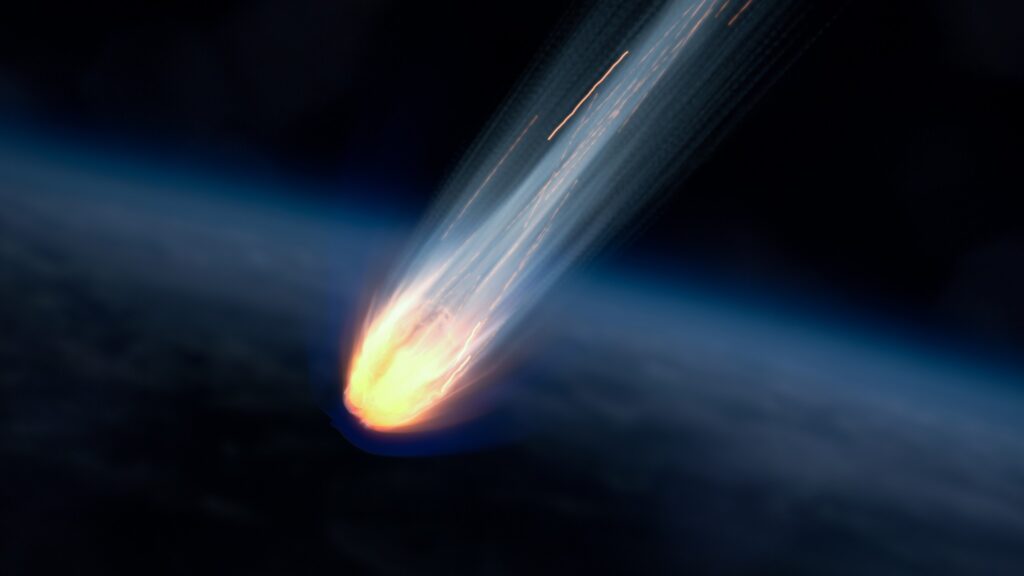The full moon of February, called the Snow Moon, will occur in the eastern U.S. during the wee hours of Saturday, Feb. 27, at 3:17 a.m. EST (0817 GMT). Early risers will see Mercury at its highest point in the predawn sky.
In New York City moonrise is at 5:02 p.m. local time the evening of Feb. 26, and moonset is the next morning at 7:05 a.m., according to timeanddate.com. The sun sets the evening of Feb. 26 at 5:44 p.m. That means the almost-full moon will be in the sky before sunset — looking east from mid-northern latitudes one will see the moon just rising as the sun goes down.
As one goes further south the time of moonrise gets later; in Miami the moon rises the evening of Feb. 26 at 5:52 p.m. and sets on Feb. 27 at 7:12 a.m. The sun and moon will still be in the sky together at sunset, but for slightly less time than in New York — the sun sets in Miami on Feb. 26 at 6:21 p.m., so both will be visible for 29 minutes as opposed to 42 minutes in New York.
Related: The moon: 10 surprising lunar facts

Meanwhile, in Melbourne, Australia, the moon is full on Feb. 27 at 7:17 p.m. local time, and doesn’t rise until 8:23 p.m. The sun will set that day at 8:02 p.m., so mid-southern latitudes will not see the sun and almost-full moon in the sky at the same time.
The full moon happens when the moon is exactly on the opposite side of the Earth from the sun. The timing of lunar phases is the same all over the world, the differences are due to time zones. When the moon rises and sets depends on latitude and season; just like the sun, the full moon will cross the sky at a different altitude in summer and winter. In the Northern Hemisphere, winter full moons tend to be relatively high in the sky, whereas in the summer they are lower. The reverse is true in the Southern Hemisphere.
This is related to why some people on Earth can see the full moon in the sky at the same time as the sun (if at sunset) and some cannot. The Earth’s rotational axis is tilted about 23.5 degrees from the vertical; this tilt is why we have seasons. In the Northern Hemisphere winter that means nights get longer. So even though the sun and moon are exactly 180 degrees apart (as measured from Earth along the plane of its orbit, known as the ecliptic) the angle measured across the sky parallel to the horizon can be less than that (or more, if one is in the Southern Hemisphere).
Related: Infinite loop: See the sun’s yearlong figure-eight in the sky (photo)
More full moon info:
Binoculars or a small telescope will make the full moon appear so bright that a lot of detail can get washed out. The brightness isn’t dangerous to one’s eyes, but using a filter is sometimes a good idea to help spot surface details.
The issue is the lack of shadows to give contrast — we are seeing the lunar surface at noontime on the moon, so the sun (from the perspective of a person standing on the moon) is directly overhead. If one waits a few days after the full moon or observes a few days before, shadows bring out more detail.
Being in the constellation Leo, the lion, the moon will be between the star Regulus, the brightest in that constellation, and Denebola, the second-brightest. When the moon reaches its highest point in the sky, shortly after midnight on Feb. 27, it will be 62 degrees above the southern horizon.
Visible planets
As the moon rises the first (and only) planet to become visible will be Mars. Shining at a magnitude of 0.9 it will be in the south-southwest at sunset, but it will take about a half hour to become visible. By 6:30 p.m., however, it should be one of the first bright “stars” to show itself (a good exercise is to see how soon after sunset one can catch it). The planet will be high; some 63 degrees above the horizon in New York, and it will set there at 12:20 a.m. local time on Feb 27.
On the morning of Feb. 27, Mercury rises at 5:24 a.m. in New York, and it will be at its highest in the morning sky (for Northern Hemisphere sky watchers), according to In-The-Sky.org. It will still be a challenge to observe, as the sun rises at 6:32 a.m. The planet will only reach 11 degrees in altitude above the southeastern horizon when day breaks.

Mercury will form a triplet of sorts with Jupiter and Saturn. About a half hour before sunrise, as seen from New York, the two giants of our solar system will be “framing” Mercury, with Saturn higher up (about 7 degrees) and Mercury to the Saturn’s left. Jupiter will be only about 3 degrees above the horizon and below and to the left of Mercury. By sunrise, Saturn will be about 12 degrees high and Jupiter about 9 degrees.
Once again, antipodeans have the advantage. Observers in Melbourne, Australia will see Saturn rise first, at about 4:34 a.m. local time on Feb. 27, followed by Mercury at 4:59 a.m. and Jupiter at 5:13 a.m.; sunrise is at 7:02 a.m. About 30 minutes before sunrise Saturn will be 23 degrees high and nearly due east. Mercury will appear almost directly below it at 18 degrees, and Jupiter will be below and to the right of Mercury at about 15 degrees. All three planets — especially Jupiter and Saturn — will be bright enough that they should be visible even as the fainter stars fade.
Constellations
The full moon tends to overwhelm fainter stars, but it will share the sky with bright winter constellations that are still visible. During February Taurus, the bull will be high in the south at sunset. It’s brightest star is Aldebaran, which will be to the left of the planet Mars. Both are identifiable by a distinct reddish hue, though Aldebaran is a bit more orange-yellow. Just below Taurus is Orion, the hunter, and to its left is the constellation of Gemini, the twins.
Looking south (below and slightly to the left) from Orion is Canis Major, the big dog, home to Sirius, the brightest star in the sky.
Mid-southern latitude sky watchers, meanwhile, will see an “upside down” Orion and Taurus in the northwest, with Aldebaran to the right and above Mars. The Southern Cross near the meridian just after sunset, and below it will be Centaurus, home to Alpha Centauri, the closest star to our solar system. The Southern Cross and Centaurus are both in the Milky Way, and as you turn your attention towards the zenith (the point directly overhead) you will see the constellations of Puppis, Vela and Carina, the three constellations — the deck, sail and hull — that make up the Argo, the ship.
How the “Snow Moon” got its name
According to the Ontario Native Literacy Project, the Anishinaabe peoples called the February full moon Mkwa Giizis, the Bear Moon. The Cree called it the Kisipisim, or the Great Moon.
The Tlingit of the Pacific Northwest call the February full moon S’eek Dís, or Black Bear Moon, while the Haida called it Hlgit’ún Kungáay, or “Goose moon,” according to the Tlingit Moon and Tide Teaching Resource published by the University of Alaska at Fairbanks.
In the Southern Hemisphere, February is during the summer, and the Māori of New Zealand described the lunar month in February to March (as measured between the successive new moons, with the full moon halfway between) as Poutū-te-rangi or “the crops are now harvested,” according to the Encyclopedia of New Zealand.
In China, the traditional lunar calendar calls the February lunation the first month, Zhēngyuè (正月, “start month”) and it is when the traditional Chinese Lunar New Year is celebrated (the New Year begins on the day of the new moon, the full moon is halfway through the month).
For Muslims, the February 2021 lunation (starting with the new moon on Feb. 13) marks the start of Rajab, the seventh month and a time in which battles are prohibited.
On the Jewish Calendar the February lunation is the month of Adar, and on the 14th day, which would be close to the full moon, Jews celebrate Purim. (The Gregorian calendar date is sunset on Feb. 25 to sunset on Feb. 26). Purim commemorates the rescue of the Jewish people from Hamam, a 5th century BCE Persian official who had planned to kill all the Jews in the Empire but was foiled by Esther, as recounted in the Biblical book of the same name.
Follow us on Twitter @Spacedotcom and on Facebook.


